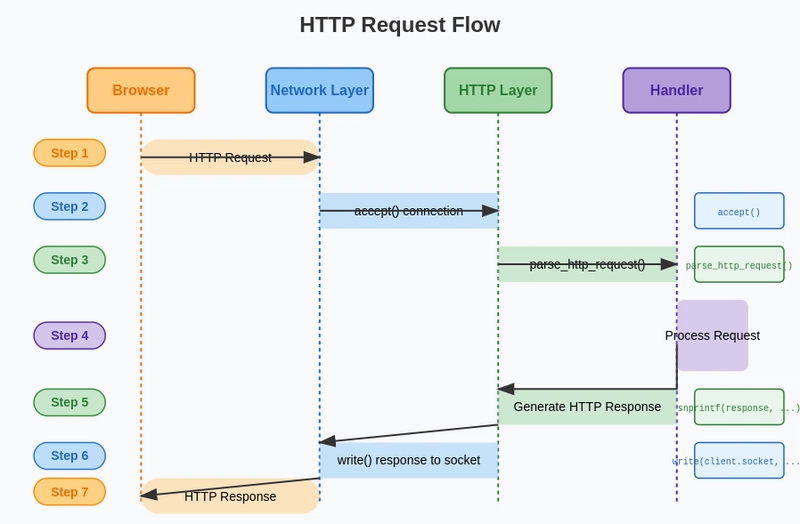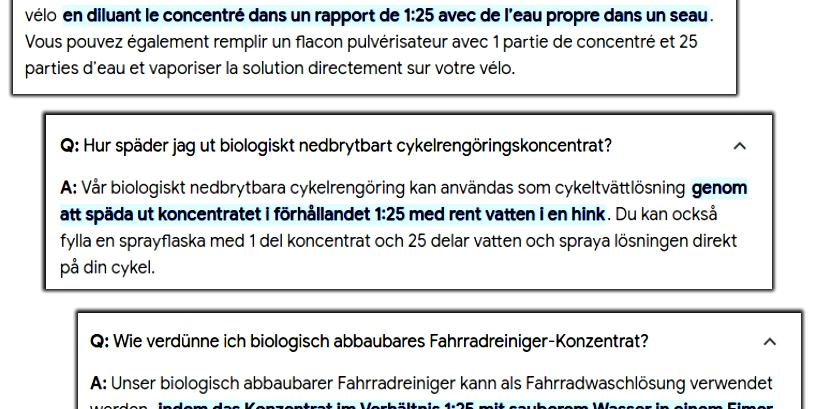How to Build a Simple HTTP Server in C: A Beginner's Guide
Building practical applications remains the best way to master C programming. A web server project offers an excellent opportunity to learn systems programming, networking fundamentals, and HTTP protocols simultaneously. The C HTTP server project described below emerged from collaboration with Antony Oduor, a senior fullstack developer at Zone 01 Kisumu who leads the development efforts, while I've partnered to lead the documentation initiatives. Note: The project currently exists as a work in progress. Both codebase and documentation undergo continuous improvement and expansion. Why Build a Web Server in C? According to Antony Oduor: "C gives you the control that modern frameworks hide away. Understanding low-level implementation makes you a more effective developer across all languages." The benefits of developing a web server in C include: Deep protocol understanding: Gain intimate knowledge of how HTTP actually works Networking insights: Learn socket programming fundamentals applicable across platforms Memory management mastery: Practice proper allocation, tracking, and freeing of resources Performance optimization: Create highly efficient server code without framework overhead Architectural knowledge: Understand how larger systems get built from smaller components Project Architecture The server follows a modular design with clear separation of concerns: c-http-server/ ├── src/ │ ├── main.c # Program entry point │ └── lib/ # Component libraries │ ├── env/ # Environment configuration │ ├── http/ # Protocol implementation │ └── net/ # Socket programming └── Makefile # Build automation Component Flow Diagram The server architecture diagram illustrates the relationships between components: Each component serves a specific purpose: main.c: Initializes the server, configures settings, and defines routes net library: Handles all socket operations and client connection management http library: Processes raw requests, manages routing, and generates responses env library: Provides configuration through environment variables HTTP Request Lifecycle The request lifecycle diagram demonstrates how data flows through the system: A detailed examination of each step reveals: Client Connection: Browser connects to the server socket Request Reading: Server accepts the connection and reads raw HTTP data Parsing: The raw string gets converted into a structured Request object Route Matching: The URL path determines which handler function executes Response Generation: The handler produces HTML or other content Response Transmission: Data flows back to the client Connection Closure: The socket closes to free resources Network Layer Deep Dive The networking component abstracts socket operations into clear functions: int listener(char* host, int port) { int sock = socket(AF_INET, SOCK_STREAM, 0); // Socket configuration code... } Key network layer aspects include: Socket creation: Establishes an endpoint for communication Address binding: Associates the socket with a specific port and address Connection listening: Prepares for incoming client connections Client acceptance: Creates individual connections for each request Data transmission: Sends and receives bytes efficiently HTTP Parser Implementation The HTTP parser transforms raw strings into structured data: Request* parse_http_request(const char* raw_request) { // Parsing implementation using state machine... } The parser uses a state machine approach to process HTTP data: Parse the request line (GET /path HTTP/1.1) Extract headers (Name: Value) Identify request body if present Populate a structured Request object Router System The routing mechanism maps URL paths to handler functions: Router router = {{"/","/about",NULL}, {Index,About,NULL}}; Under the hood, the router: Compares the requested path against registered patterns Invokes the appropriate handler function when matched Generates a 404 response when no match exists Running the Server Starting the server requires minimal setup: # Clone the repository git clone https://github.com/oduortoni/c-http-server.git cd c-http-server # Build and launch make # Visit in browser: http://127.0.0.1:9000 Configuration through environment variables allows customization: # Set custom port export PORT=8080 # Set custom host export HOST=0.0.0.0 # Build and run with custom settings make Creating Custom Routes Adding new functionality requires three steps: Define a handler function: int ContactPage(ResponseWriter w, Request r) { // Generate HTML content... return 0; } Register the route in main.c: http.HandleFunc("/contact", ContactPage); Update the router configuration: Router router = {{"/", "/
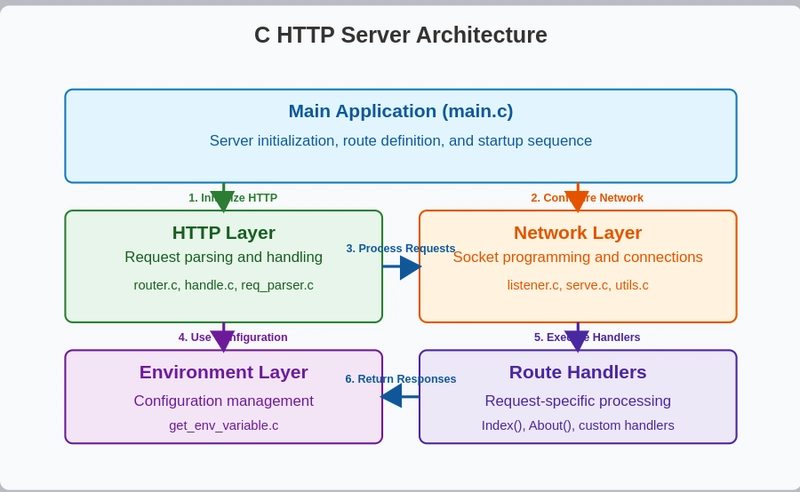
Building practical applications remains the best way to master C programming. A web server project offers an excellent opportunity to learn systems programming, networking fundamentals, and HTTP protocols simultaneously.
The C HTTP server project described below emerged from collaboration with Antony Oduor, a senior fullstack developer at Zone 01 Kisumu who leads the development efforts, while I've partnered to lead the documentation initiatives.
Note: The project currently exists as a work in progress. Both codebase and documentation undergo continuous improvement and expansion.
Why Build a Web Server in C?
According to Antony Oduor:
"C gives you the control that modern frameworks hide away. Understanding low-level implementation makes you a more effective developer across all languages."
The benefits of developing a web server in C include:
- Deep protocol understanding: Gain intimate knowledge of how HTTP actually works
- Networking insights: Learn socket programming fundamentals applicable across platforms
- Memory management mastery: Practice proper allocation, tracking, and freeing of resources
- Performance optimization: Create highly efficient server code without framework overhead
- Architectural knowledge: Understand how larger systems get built from smaller components
Project Architecture
The server follows a modular design with clear separation of concerns:
c-http-server/
├── src/
│ ├── main.c # Program entry point
│ └── lib/ # Component libraries
│ ├── env/ # Environment configuration
│ ├── http/ # Protocol implementation
│ └── net/ # Socket programming
└── Makefile # Build automation
Component Flow Diagram
The server architecture diagram illustrates the relationships between components:
Each component serves a specific purpose:
- main.c: Initializes the server, configures settings, and defines routes
- net library: Handles all socket operations and client connection management
- http library: Processes raw requests, manages routing, and generates responses
- env library: Provides configuration through environment variables
HTTP Request Lifecycle
The request lifecycle diagram demonstrates how data flows through the system:
A detailed examination of each step reveals:
- Client Connection: Browser connects to the server socket
- Request Reading: Server accepts the connection and reads raw HTTP data
- Parsing: The raw string gets converted into a structured Request object
- Route Matching: The URL path determines which handler function executes
- Response Generation: The handler produces HTML or other content
- Response Transmission: Data flows back to the client
- Connection Closure: The socket closes to free resources
Network Layer Deep Dive
The networking component abstracts socket operations into clear functions:
int listener(char* host, int port) {
int sock = socket(AF_INET, SOCK_STREAM, 0);
// Socket configuration code...
}
Key network layer aspects include:
- Socket creation: Establishes an endpoint for communication
- Address binding: Associates the socket with a specific port and address
- Connection listening: Prepares for incoming client connections
- Client acceptance: Creates individual connections for each request
- Data transmission: Sends and receives bytes efficiently
HTTP Parser Implementation
The HTTP parser transforms raw strings into structured data:
Request* parse_http_request(const char* raw_request) {
// Parsing implementation using state machine...
}
The parser uses a state machine approach to process HTTP data:
- Parse the request line (GET /path HTTP/1.1)
- Extract headers (Name: Value)
- Identify request body if present
- Populate a structured Request object
Router System
The routing mechanism maps URL paths to handler functions:
Router router = {{"/","/about",NULL}, {Index,About,NULL}};
Under the hood, the router:
- Compares the requested path against registered patterns
- Invokes the appropriate handler function when matched
- Generates a 404 response when no match exists
Running the Server
Starting the server requires minimal setup:
# Clone the repository
git clone https://github.com/oduortoni/c-http-server.git
cd c-http-server
# Build and launch
make
# Visit in browser: http://127.0.0.1:9000
Configuration through environment variables allows customization:
# Set custom port
export PORT=8080
# Set custom host
export HOST=0.0.0.0
# Build and run with custom settings
make
Creating Custom Routes
Adding new functionality requires three steps:
- Define a handler function:
int ContactPage(ResponseWriter w, Request r) {
// Generate HTML content...
return 0;
}
- Register the route in main.c:
http.HandleFunc("/contact", ContactPage);
- Update the router configuration:
Router router = {{"/", "/about", "/contact", NULL},
{Index, About, ContactPage, NULL}};
Form Processing
The server includes built-in form handling capabilities:
- Parses form submissions from POST requests
- Extracts individual form fields from the request body
- URL-decodes field values for proper character representation
- Generates appropriate responses based on submitted data
Advanced Features Under Development
The project continues to evolve with several features in active development:
- Static file serving: Deliver images, stylesheets, and client-side scripts
- Enhanced error handling: More detailed error responses and logging
- Response status codes: Full implementation of HTTP status responses
- Memory optimization: Improved buffer management for large requests
- Concurrency: Multi-threaded request handling
Key Learning Opportunities
Studying the implementation offers valuable lessons in several fundamental programming concepts:
1. C Programming Patterns
Structures
The code uses structures to organize related data, creating clean abstractions:
struct Request {
char method[MAX_METHOD_LEN];
char path[MAX_PATH_LEN];
char version[MAX_VERSION_LEN];
struct Header headers[MAX_HEADERS];
int header_count;
char body[MAX_BODY_LEN];
size_t body_length;
};
Function Pointers
Function pointers enable flexible behavior and callback patterns:
typedef int(*HandlerFunc)(ResponseWriter w, Request r);
struct Router {
char* patterns[50];
HandlerFunc handlers[50];
};
Memory Management
Proper allocation and freeing prevents memory leaks:
Request* req = parse_http_request(buffer);
// Use request...
free_request(req); // Clean up when done
2. Network Programming
Socket Creation
Creating communication endpoints:
int sock = socket(AF_INET, SOCK_STREAM, 0);
if(sock < 0) {
perror("socket() could not create a socket");
exit(1);
}
Connection Handling
Accepting and processing client connections:
int client_conn = accept(server_socket, (struct sockaddr*)&client_addr, &client_addrlen);
printf("Accepted connection from %s:%d\n", inet_ntoa(client_addr.sin_addr), ntohs(client_addr.sin_port));
3. Protocol Implementation
HTTP Request Parsing
Breaking down HTTP protocol messages:
case PARSE_METHOD: {
char* method_ptr = req->method;
while (*p && !isspace(*p)) {
*method_ptr++ = *p++;
}
*method_ptr = '\0';
state = PARSE_PATH;
}
Header Processing
Extracting and storing HTTP headers:
for (int i = 0; i < req->header_count; i++) {
if (strcasecmp(req->headers[i].name, "Content-Length") == 0) {
content_length = atoi(req->headers[i].value);
}
}
Response Formation
Constructing properly formatted HTTP responses:
snprintf(response, sizeof(response),
"HTTP/1.1 200 OK\r\n"
"Content-Type: text/html\r\n"
"\r\n%s", html_content);
4. State Machines
Parser States
Using enumerated states to track parsing progress:
enum ParseState {
PARSE_METHOD, PARSE_PATH, PARSE_VERSION,
PARSE_HEADER_NAME, PARSE_HEADER_VALUE,
PARSE_BODY, PARSE_COMPLETE, PARSE_ERROR
};
State Transitions
Transitioning between states based on input:
switch (state) {
case PARSE_METHOD:
// Process method...
state = PARSE_PATH;
break;
case PARSE_PATH:
// Process path...
state = PARSE_VERSION;
break;
}
Error Handling
Detecting and handling error conditions in the state machine:
if (state == PARSE_ERROR) {
free(req);
return NULL;
}
5. Modular Design
Component Separation
Organizing code into logical directories and files:
src/lib/net/listener.c // Network functions
src/lib/http/handle.c // HTTP processing
src/lib/env/get_env_variable.c // Configuration
Interface Definitions
Creating clear interfaces between components:
// In header.h
int serve(char *host, Processor processor);
int listener(char* host, int port);
// Implementation in separate files
Composition
Building complex behavior from simple components:
// Composing components together
Processor processor = {handle_connection, &router};
serve(host, processor);
Each of these concepts builds essential programming skills that apply across multiple domains, not just web servers. Understanding these patterns helps in building robust, maintainable software systems regardless of the specific application domain.
Building an HTTP server in C provides fundamental knowledge applicable across all web development. The complete project with documentation reveals how seemingly complex systems can be built through well-designed components working together.
The skills gained from exploring low-level server implementation remain valuable regardless of which languages or frameworks become popular in the future. Understanding what happens "under the hood" makes for more effective development at all levels.
Explore the complete project on GitHub to deepen your understanding of both C programming and web servers.
Antony Oduor is a Fullstack Developer at Zone 01 Kisumu, who leads the development of the project.












































































































































































![[The AI Show Episode 142]: ChatGPT’s New Image Generator, Studio Ghibli Craze and Backlash, Gemini 2.5, OpenAI Academy, 4o Updates, Vibe Marketing & xAI Acquires X](https://www.marketingaiinstitute.com/hubfs/ep%20142%20cover.png)















































































































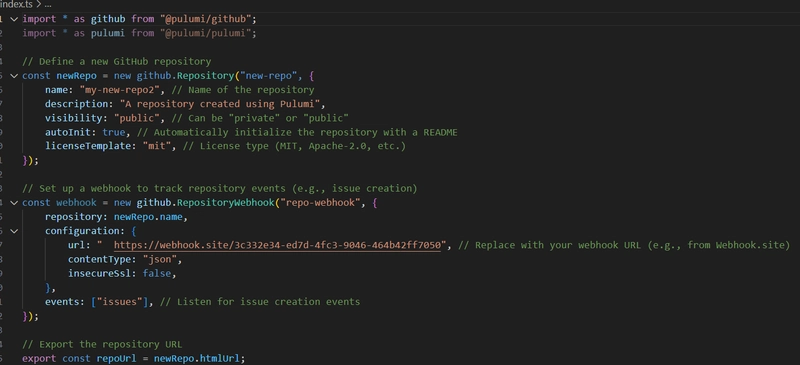

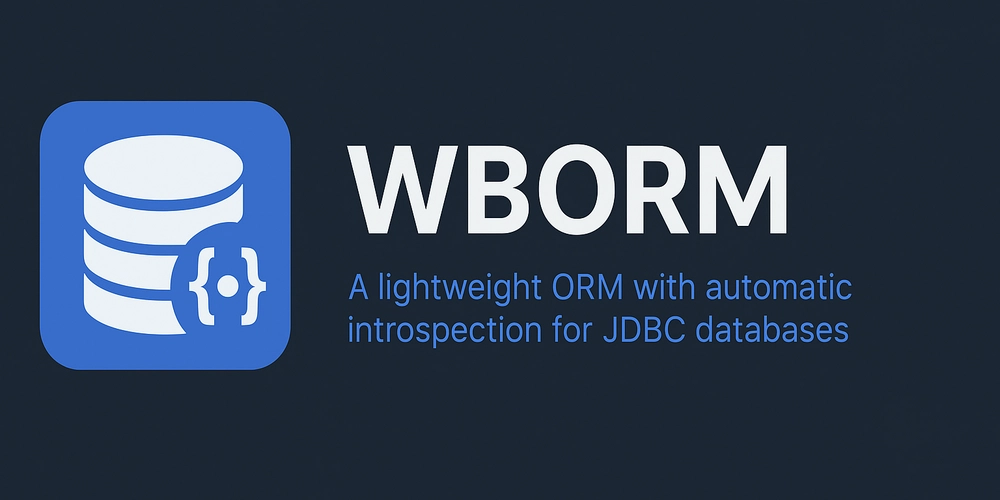









![[FREE EBOOKS] The Kubernetes Bible, The Ultimate Linux Shell Scripting Guide & Four More Best Selling Titles](https://www.javacodegeeks.com/wp-content/uploads/2012/12/jcg-logo.jpg)



![From drop-out to software architect with Jason Lengstorf [Podcast #167]](https://cdn.hashnode.com/res/hashnode/image/upload/v1743796461357/f3d19cd7-e6f5-4d7c-8bfc-eb974bc8da68.png?#)






































































































.png?#)




.jpg?#)































_Christophe_Coat_Alamy.jpg?#)






































































































![Rapidus in Talks With Apple as It Accelerates Toward 2nm Chip Production [Report]](https://www.iclarified.com/images/news/96937/96937/96937-640.jpg)






































































































































